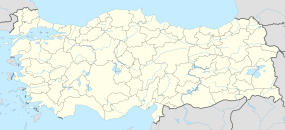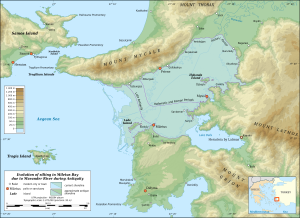A | B | C | D | E | F | G | H | CH | I | J | K | L | M | N | O | P | Q | R | S | T | U | V | W | X | Y | Z | 0 | 1 | 2 | 3 | 4 | 5 | 6 | 7 | 8 | 9
 Ancient Heraclea at the foot of Mt Latmus. At the centre-right is the c. 3 BCE temple of Athena. | |
| Coordinates | 37°29′51″N 27°31′37″E / 37.49759°N 27.52707°ECoordinates: 37°29′51″N 27°31′37″E / 37.49759°N 27.52707°E |
|---|---|
| History | |
| Periods | Archaic Greece |
Heraclea at Latmus (Ancient Greek: Ἡράκλεια πρὸς Λάτμῳ, romanized: Herakleia pros Latmo; Latin: Heraclea ad Latmum), or simply Heraclea or Herakleia (Ἡράκλεια), also transliterated as Heracleia, was an ancient town on the confines between ancient Caria and Ionia, situated at the western foot of Mount Latmus. It occupies a picturesque site on the shore of Lake Bafa which in ancient times was part of the Gulf of Latmus on which were several cities including Miletus, Priene, and Myus before their ports were silted up by deposits of the river Maeander.
Impressive ruins of the town still exist.
Its site is co-located with the village of Kapıkırı, Asiatic Turkey.[1][2]
History
Originally called Latmos, during the 5th century BC the city was listed as a member of the Delian league.[3] Then in the 4th century BC, king Mausolos conquered the town and it was renamed Heraclea.[4]
Mausolos is credited with building the impressive walls of Heraclea which were enhanced by Lysimachus around 287 BC and are among the best preserved of this type in the world. The walls had a total length of about 6.5 km with 65 towers which are still remarkably well preserved.
The town was later called Pleistarcheia,[4] a name which is mentioned by Stephanus of Byzantium who writes that the city was originally called Herakleia, then Pleistarcheia, and then Herakleia again. The name Pleistarcheia is attributed to Pleistarchus, brother of king Cassander, who is recorded as being the king of the region of Caria after the battle of Ipsus which took place in 301 BC.[4]
The town also holds the resting place of Endymion, a mythical figure who was put to sleep by Zeus for eternity, and Pausanias writes that the people of Heraclea honour him at a shrine in this spot.[5][6][7][8]
Heraclea is thought to have been Christianised early, as an early bishopric is attested. No longer a residential see, it remains a titular see of the Roman Catholic Church.[9]
Site
The city was built on a Hippodamian grid,[10][3] the temple of Athena being the only structure in the city that does not follow this method. The temple of Athena is the city’s main temple and sits west of the agora.
In the city centre is a large agora containing two-story shops. The city also contains three temples, a bathhouse, a bouleuterion, a necropolis, and a nymphaeum.[11]
References
- ^ Richard Talbert, ed. (2000). Barrington Atlas of the Greek and Roman World. Princeton University Press. p. 61, and directory notes accompanying.
- ^ Lund University. Digital Atlas of the Roman Empire.
- ^ a b "The Princeton Encyclopedia of Classical Sites, HERAKLEIA UNDER LATMOS Caria, Turkey". www.perseus.tufts.edu. Retrieved 2021-12-09.
- ^ a b c Hülden, Oliver (2012-01-01). "Herakleia by Latmos". The Encyclopedia of Ancient History.
- ^ Periplus of Pseudo-Scylax, p. 39; Strabo. Geographica. Vol. xiv. p.635. Page numbers refer to those of Isaac Casaubon's edition.
- ^ Ptolemy. The Geography. Vol. 5.2.9.
- ^ Pliny. Naturalis Historia. Vol. 5.31.
- ^ Polyaen. 7.23; Schol. ad Apollon. Rhod. 4.57; Pausanias. Description of Greece. Vol. 5.1.4.
- ^ Catholic Hierarchy
- ^ "Heracleia by Latmus | Turkish Archaeological News". turkisharchaeonews.net. Retrieved 2021-12-09.
- ^ "Herakleia under Latmus (Site)". www.perseus.tufts.edu. Retrieved 2021-12-09.
![]() This article incorporates text from a publication now in the public domain: Smith, William, ed. (1854–1857). "Heracleia". Dictionary of Greek and Roman Geography. London: John Murray.
This article incorporates text from a publication now in the public domain: Smith, William, ed. (1854–1857). "Heracleia". Dictionary of Greek and Roman Geography. London: John Murray.
>Text je dostupný pod licencí Creative Commons Uveďte autora – Zachovejte licenci, případně za dalších podmínek. Podrobnosti naleznete na stránce Podmínky užití.
Text je dostupný za podmienok Creative
Commons Attribution/Share-Alike License 3.0 Unported; prípadne za ďalších
podmienok.
Podrobnejšie informácie nájdete na stránke Podmienky
použitia.






